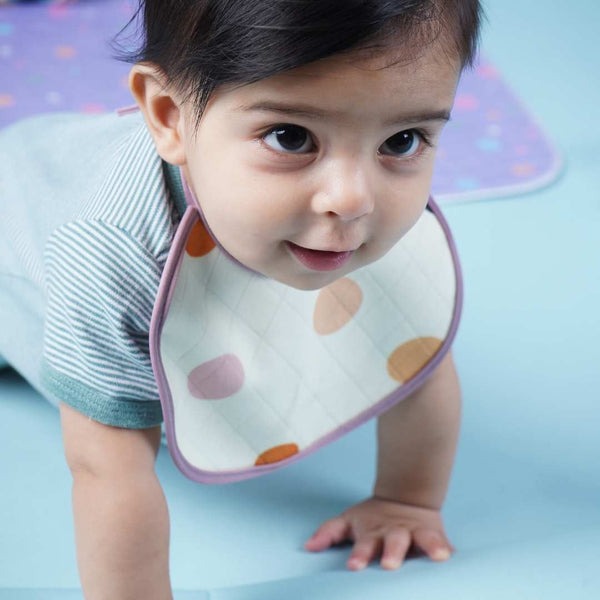As parents, we know that caring for a baby involves a lot of little decisions, some of which are surprisingly impactful. One of the most common daily tasks that parents often overlook is how to dry baby bibs. It may seem like a small concern, but when you consider the amount of bibs you go through each day, the drying method can make a big difference to the longevity of the bibs, their softness, and even their safety for your baby. The two most popular drying methods—air drying and tumble drying—each have their pros and cons. Let’s take a closer look at how these methods compare, particularly when it comes to something as sensitive as baby bibs.
The Case for Air Drying
When it comes to baby products, air drying is often considered the gentler option, and for good reason. It’s the method that many parents instinctively choose when they want to preserve the integrity of their baby’s clothes and accessories, including bibs. But, why exactly is air drying so favored?
One of the key benefits of air drying is that it’s the most natural way to dry fabrics. Baby bibs, often made from soft materials like cotton or organic fabrics, can sometimes be delicate. Air drying helps prevent the wear and tear that can come from the high heat of a tumble dryer, which can break down fibers over time. For bibs that are used daily—whether at mealtimes or for drool management—keeping the fabric in the best possible condition is essential.
Air drying also offers the advantage of being more energy-efficient. By simply hanging the bibs up to dry, you avoid the electricity consumption that comes with running a tumble dryer. For eco-conscious parents, this is a major consideration. Additionally, since you’re not using a machine, there’s less chance of any accidental damage that could occur from over-drying or an overly hot cycle.
However, air drying is not without its challenges. It can take time. Depending on the climate and where you live, air drying baby bibs can be a slow process. If you’re juggling multiple bibs a day—think of mealtimes, teething stages, or general messes—the drying time might not keep up with the demand. In these cases, air drying may require a bit more patience or strategic planning. Additionally, hanging bibs out to dry might require space, which is sometimes a challenge for parents who don’t have much room for drying racks or clotheslines.
Tumble Drying Baby Bibs
On the other side of the coin, tumble drying offers a quick and convenient way to dry your baby’s bibs. For parents who are always on the go, the convenience of a tumble dryer can’t be overstated. It’s as simple as tossing the bibs in, selecting the right setting, and letting the machine do its work.
Tumble drying can also help keep the bibs soft and fluffy, especially when using the appropriate heat setting or dryer balls. Many parents find that their baby’s bibs feel even more comfortable when they’ve been dried in the tumble dryer because the fabric is less stiff. If you’ve ever dealt with air-dried fabrics that can become a bit crunchy or hard, you’ll understand the appeal of tumble drying for added softness.
Moreover, tumble drying is undoubtedly faster than air drying, especially if you’re in a rush. If your baby goes through several bibs a day (and let’s be honest, most babies do), being able to dry them quickly is a huge advantage. The speed of tumble drying allows you to keep up with the constant need for fresh bibs throughout the day. In this sense, it’s the perfect option for busy parents who can’t afford to wait hours for their baby’s bibs to dry.
However, tumble drying does have some downsides, especially when it comes to baby clothes and accessories. The high heat from the dryer can cause fabrics to shrink or lose their softness over time. Some bibs are made from materials like cotton, which is particularly susceptible to shrinkage. This can be frustrating for parents who want their baby’s items to maintain their shape and fit for as long as possible.
Another potential issue with tumble drying is the risk of the bibs becoming damaged due to high heat or aggressive spinning cycles. For instance, fast spins can result in snags or tears, particularly in delicate bibs. Additionally, the intense heat of the dryer can degrade any special features on the bib, such as waterproofing or embellishments, diminishing the overall quality and durability.
Material Considerations: Not All Bibs Are Created Equal
When deciding between air drying and tumble drying, the type of material your baby’s bibs are made from plays a critical role. Not all fabrics respond the same way to heat or moisture, so it’s important to check the care instructions that accompany your bibs. Materials like cotton, which is common for bibs, can typically withstand both drying methods, but it’s still essential to be mindful of how they’re treated.
Bibs made from organic cotton or bamboo fabrics, for example, may have different drying requirements. These materials tend to be more delicate, and while they’re environmentally friendly and gentle on a baby’s skin, they may require a gentler drying method. For such bibs, air drying is often recommended to maintain their softness and prevent premature wear.
Alternatively, if the bibs have a backing made of waterproof material (to prevent spills from seeping through), tumble drying could potentially cause the waterproof coating to deteriorate. In this case, air drying might be the safer option to preserve the bib’s function and effectiveness.
The Convenience Factor
Let’s be real for a moment—parenting is busy. Between feedings, naps, playtime, and managing daily routines, the last thing you want to worry about is how long it will take for a bib to dry. This is where tumble drying has the upper hand for many parents. With the press of a button, the bibs are quickly ready for the next meal. Air drying, on the other hand, may require you to plan ahead, especially when you’re running low on fresh bibs.
While air drying can be the more careful and eco-friendly option, it’s not always the most practical for parents who need a fast solution. That’s why finding a balance between the two methods might be your best bet. For example, if you have a day where your baby goes through several bibs, you could rotate between both drying methods—air drying on one day and tumble drying on another—depending on the circumstances.
Caring for Baby Bibs in the Long Term
Regardless of the drying method you choose, it’s important to consider the long-term care of your baby’s bibs. Over time, frequent drying can affect the overall quality of the fabric. Whether you’re air drying or tumble drying, regularly inspect the bibs for any signs of wear, such as fading, fraying, or thinning. Taking care to follow care instructions and maintaining a balance between the two drying methods will help your baby’s bibs last longer, saving you money in the long run and ensuring that your baby stays comfortable.
Suggested Reading: How a Snakes and Ladders Picnic Mat Can Turn Any Outdoor Gathering into a Game Night
Conclusion
In the debate between air drying and tumble drying baby bibs, there’s no one-size-fits-all answer. Both methods have their advantages and challenges. Air drying is gentle, eco-friendly, and helps preserve the integrity of the bibs, but it can be slow and less convenient. Tumble drying, on the other hand, is faster, more convenient, and leaves the bibs feeling soft, but the heat can damage delicate fabrics over time. The best approach is to understand the materials of your baby’s bibs, the frequency of use, and your own lifestyle needs. With a little balance, you can ensure that your baby’s bibs stay in excellent condition and that drying doesn’t become a stress point in your already busy parenting routine.
For those who are looking for high-quality baby bibs that combine style, functionality, and durability, check out Happy Matty’s collection at Happy Matty Store. Their thoughtful designs ensure that both air drying and tumble drying options are catered to, providing parents with a solution that works best for them and their baby’s needs.



